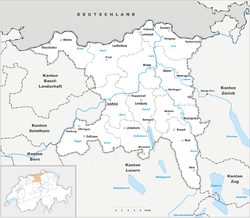Canton of Aargau
| Kanton Aargau | ||
|---|---|---|
| Canton of Switzerland | ||
|
||
 Location in Switzerland |
||
| Coordinates: 47°5′N 8°0′E / 47.083°N 8.000°ECoordinates: 47°5′N 8°0′E / 47.083°N 8.000°E | ||
| Capital | Aarau | |
| Largest City | Wettingen | |
| Subdivisions | 213 municipalities, 11 districts | |
| Government | ||
| • Executive | Executive Council (5) | |
| • Legislative | Grand Council (140) | |
| Area | ||
| • Total | 1,403.73 km2 (541.98 sq mi) | |
| Population (12/2015) | ||
| • Total | 653,675 | |
| • Density | 470/km2 (1,200/sq mi) | |
| ISO 3166 code | CH-AG | |
| Highest point | 908 m (2,979 ft): Geissfluegrat | |
| Lowest point | 260 m (853 ft): Rhine at Kaiseraugst | |
| Joined | 1803 | |
| Languages | German | |
| Website | AG.ch | |
The canton of Aargau (German Kanton ![]() Aargau ; sometimes anglicized Argovia; see also other names) is one of the more northerly cantons of Switzerland. It is situated by the lower course of the Aare, which is why the canton is called Aar-gau (meaning Aare province). It is one of the most densely populated regions of Switzerland.
Aargau ; sometimes anglicized Argovia; see also other names) is one of the more northerly cantons of Switzerland. It is situated by the lower course of the Aare, which is why the canton is called Aar-gau (meaning Aare province). It is one of the most densely populated regions of Switzerland.
The area of Aargau and the surrounding areas were controlled by the Helvetians, a member of the Celts, as far back as 200 BC, eventually being occupied by the Romans and then by the 6th century, the Franks. The Romans built a major settlement called Vindonissa, near the present location of Brugg.
In early medieval times, the Aargau was a disputed border region between the duchies of Alamannia and Burgundy. A line of the von Wetterau (Conradines) intermittently held the countship of Aargau from 750 until about 1030, when they lost it (having in the meantime taken the name von Tegerfelden). From the extinction in 1254 of the Hohenstaufen dynasty until 1415, the area was ruled by the Habsburgs, and many castles from that time still stand (examples include Habsburg, Lenzburg, Tegerfelden, Bobikon, Stin and Wildegg). The Habsburgs founded a number of monasteries (with some structures enduring, e.g., in Wettingen and Muri), the closing of which by the government in 1841 was a contributing factor to the outbreak of the Swiss civil war – the "Sonderbund War" – in 1847.
...
Wikipedia


